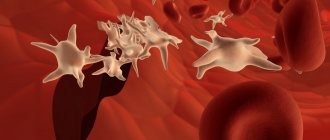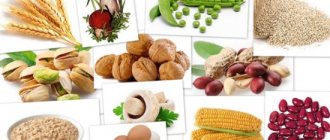Causes of hypovitaminosis
Vitamin deficiency may be due to one or more of these reasons:
- Lack of vitamin in the diet, unbalanced diet
- Destruction of nutrients in food containing them due to violations of storage conditions or as a result of temperature or other cooking
- The action of antagonist substances that are contained in certain products and lead to the destruction of vitamins, disruption of their absorption, and an increase in a person’s need for vitamins (in particular, egg white makes it difficult to absorb biotin).
Hypovitaminosis can also be caused by endogenous (internal causes). These include, first of all, various disorders of the gastrointestinal tract, leading to disruption of the absorption and assimilation of vitamins. Often, insufficient absorption of vitamins is caused by dysbiosis - a disorder of the intestinal microflora, which often accompanies long-term use of antibiotics, chemotherapy for tuberculosis, and cancer. Microflora is involved in the process of synthesis of certain vitamins, which occurs inside the body; the deterioration of its condition, the presence of pathogenic microorganisms in it, as well as helminthic and other parasitic infestations lead to a sharp reduction in vitamin reserves in the body.
Other common causes of vitamin deficiency include genetically determined defects in enzyme systems and transport functions that ensure the absorption and distribution of vitamins. Taking certain medications can also cause hypovitaminosis.
A separate group should include reasons that are not associated with a lack of vitamin in food or impaired absorption, but with an increase in human need for this substance. Such reasons may be pregnancy and lactation, periods of increased physical and mental stress, intensive growth in adolescence and childhood, and other factors.
Description
According to the ICD 10 classification, hypovitaminosis is defined as “Vitamin deficiency, unspecified” with code E56.9.
Disappointing statistics say that more than 80% of the world's population is deficient in ascorbic acid (vitamin C), two-thirds of people suffer from other types of vitamin deficiency.
Hypovitaminosis is not characterized by a pronounced clinical picture; the symptoms are usually vague - fatigue, memory impairment, minor external manifestations (changes in the condition of the skin, hair, mucous membranes), and a general decrease in immune status.
Deterioration in a person’s health is often perceived as a consequence of physical or emotional fatigue, stressful situations, and other false reasons. Therefore, there is a danger of missing the moment of transition of hypovitaminosis into vitamin deficiency, a more serious pathology.
Symptoms of hypovitaminosis
Manifestations of vitamin deficiency can be very diverse, but most often patients with this diagnosis experience one or more of these symptoms:
- Peeling, dryness, roughening of the skin, cracking, dandruff, brittle nails.
- The appearance of an oily sheen on the skin, peeling of the nasolabial folds, the wings of the nose and bridge of the nose, the skin of the eyelids, and neck (especially behind the ears).
- Thickening and cracking of the skin of joints (mainly elbows and knees).
- Hemorrhages on the surface of the skin, loss of the natural color of the mucous membranes, bleeding of the mucous membranes of the gums and oral cavity.
- The appearance of general weakness, fatigue, apathy, marked deterioration of the emotional background, sleep and mood disturbances, and intellectual activity disorders.
- The appearance of jams, cracks in the corners of the mouth, dry skin of the lips, the formation of ulcerations and grayish-yellow crusts in the corners of the lips.
- The appearance of many small nodules on the skin of the thighs, elbow and knee bends, buttocks; severe dry skin in these areas.
- Decreased visual acuity, deterioration of color vision, deterioration of night vision up to the development of night blindness.
- The appearance of transverse grooves, pits on the nails, changes in the color of the nail bed or plate.
- Increased sensitivity of skin and tooth enamel.
- Decreased libido, erectile dysfunction.
- Gastrointestinal tract disorders, indigestion.
In infants, a deficiency of certain vitamins causes increased sweating (hyperhidrosis), the formation of bald spots and bald spots on the scalp, disturbances in development and growth, the formation of dry brown crusts in the area behind the ears, and delayed teething.
Some types of vitamin deficiencies lead to the development of specific diseases. For example, as a result of a lack of vitamin PP and certain types of proteins, pellagra occurs - a disease characterized by a combination of three main symptoms: diarrhea, dermatitis and dementia (blurred consciousness). In addition to these symptoms, pellagra can cause photodermatoses, baldness and other skin diseases and disorders, insomnia and weakness, increased aggressiveness, loss of sensitivity or complete paralysis of the limbs and peripheral nerves.
Vitamin A hypovitaminosis
The most common cause of the development of this disorder is a violation of the processes of absorption and assimilation of fats, which occurs in various diseases of the intestines and pancreas. Hypovitaminosis, caused by insufficient vitamin A content in food products consumed by the patient, is somewhat less common.
A lack of retinol often leads to symptoms from the skin and mucous membranes. Dry skin, the formation of scales and flaking, dermatitis and other skin diseases accompany this hypovitaminosis, along with the tendency in children to develop stomatitis (inflammation of the oral mucosa).
Vitamin A plays an important role in the visual act, influencing not only general visual acuity and color perception, but also the process of vision adaptation to darkness. With a lack of this element, daytime and twilight vision deteriorates, and conjunctivitis often develops. In severe cases of the disorder, corneal perforation, keratomalacia, and blindness may develop.
Finally, one of the common consequences of a lack of vitamin A in the body is disruption of the digestive system. In addition, immunity decreases, as a result of which patients experience frequent infectious and inflammatory diseases: gastritis and colitis, acute respiratory diseases, urinary tract infections.
Vitamin B1 hypovitaminosis
A sufficient amount of thiamine (vitamin B1) ceases to enter the body due to various gastrointestinal diseases; The need for this substance increases during pregnancy and breastfeeding. In those regions where carbohydrate foods predominate and there is excessive consumption of grain processing products, this type of hypovitaminosis is more common. The unpleasant symptoms that arise in this case are associated with a violation of the processes of carbohydrate oxidation, the occurrence of an excess amount of under-oxidized products, and a violation of the synthesis of acetylcholine.
In the early stages of hypovitaminosis, patients suffer from constipation, nausea and loss of appetite, as well as other digestive system disorders. Headaches, memory impairment and irritability are common manifestations of the nervous system, along with impaired peripheral sensitivity, a crawling sensation, and the development of neuralgia. Characterized by weakness of the heart muscle, manifested by tachycardia even with minor loads.
Vitamin B2 hypovitaminosis
Riboflavin is an extremely important vitamin for the body, which is found in large quantities in animal products, such as meat, dairy products, eggs, and even some types of plant foods, fruits and vegetables. With a lack of vitamin B2, many metabolic and energy exchange processes in the body are disrupted, and the immune status decreases.
Inflammation of the tissues of the tongue and the lining of the oral cavity (glossitis and stomatitis), cracking of the lips, eczema-like defects of the skin, conjunctivitis and photophobia are the primary signs of riboflavin deficiency. At the same time, persistent visual impairment often develops, and children’s development and growth processes are disrupted.
With hypovitaminosis of this type, the mucous membrane of the oral cavity becomes grayish, and the tongue, on the contrary, acquires a bright red tint. The surface of the tongue becomes smooth due to degeneration of the papillae.
Porridge
Cereals contain the least amount of harmful substances, including nitrogenous compounds, as well as radioactive elements. Cereals contain a lot of well-digestible vegetable protein, carbohydrates, vitamins and microelements necessary for growth. You can use very healthy and tasty cereals: oatmeal, buckwheat, wheat, barley, rice, as well as a mixture of them.
You can prepare porridge daily to supply various vitamins and microelements in different proportions, but constantly:
Monday - rice ; Tuesday - barley (pearl barley) ; Wednesday - millet ; Thursday - rye ; Friday - oats ; Saturday - corn ; Sunday - wheat .
Vitamin B3 hypovitaminosis
Children who need more vitamin B3 in their bodies experience growth retardation and weight gain. All patients with a relatively long-term lack of vitamin are characterized by the development of a number of disorders caused by a disorder in the functioning of the nervous system: such as weakness, apathy, deterioration of the emotional state. The sensitivity of the nerves is impaired, paresthesia occurs, in particular, burning syndrome in the feet. Numerous disorders of the digestive and respiratory systems are observed, and blood pressure levels decrease.
Freshly squeezed juices
The first most important is carrot juice. This juice contains a large amount of vitamins B, C, D, E, K, G. Carrot juice improves digestion, appetite and teeth structure. Daily consumption of 0.5 liters of carrot juice has greater constructive value for the body than 12 kilograms of calcium tablets. This juice is very rich in living organic elements such as sodium, potassium, phosphorus, sulfur and silicon. It also contains a lot of calcium, phosphorus and iron.
Vitamin D hypovitaminosis
Lack of vitamin D, along with some other factors, leads to the development of a specific disease - rickets. Most often, rickets develops in early childhood and is accompanied by a disturbance in the processes of bone formation and the occurrence of numerous disorders of the internal organs.
The rapid growth of the body in childhood causes an increased need for vitamin D. A lack of vitamin D can be caused not only by insufficient amounts of it in food, but also by disruption of its synthesis processes in the skin - for example, due to insufficient exposure to the sun.
At the onset of the disease, children experience sleep disturbances, sweating, restlessness, and weakened muscle tone. At later stages, due to disruption of bone formation processes, the shape of the skull and chest may change (flattening of the back of the head and intercostal joints). Together with deterioration of muscle tone, this leads to developmental delays or disorders of motor and static functions.
The role of vitamins in human life and the consequences of their deficiency
Below are some vitamins and their effects on the body. Of course, if they are insufficient, reverse processes occur.
Vitamin A (Retinol)
Vitamin A is essential for normal vision, healthy hair, healthy skin, bones and teeth. Participates in protein synthesis and normal metabolism. Is an antioxidant. It also turned out that someone who has a significant amount of vitamin A in their body can suffer a cerebral hemorrhage without any special consequences.
Hypovitaminosis A is characterized by dry skin, the appearance of wrinkles, decreased protective functions of the body, dandruff, problems with erection, insomnia, blurred vision, impaired growth and development of children.
Foods rich in vitamin A: liver, eggs, fish, cottage cheese, milk, spinach, green salad, fruits, carrots, tomatoes, parsley.
Vitamin B1 (Thiamin)
Vitamin B1 is necessary for normal growth and development. Participates in the metabolism of fats and carbohydrates. Supports normal functioning of the heart, nervous and digestive systems. Helps relieve fatigue. It is a preventive vitamin against stress.
Hypovitaminosis B1 is expressed by dysfunction of the cardiovascular system (shortness of breath, tachycardia, arterial hypotension), nervous system (increased irritability, depression, insomnia), increased fatigue, deterioration of coordination, dysfunction of the gastrointestinal tract (nausea, constipation, diarrhea, decreased appetite), decreased body weight, anorexia, numbness of the extremities, chills at room temperature. With thiamine deficiency, Beriberi disease can develop.
Foods rich in vitamin B1: liver, milk, eggs, yeast, wheat germ, peas, beans, peanuts, pine nuts, oatmeal, peeled rice, sunflower seeds, pistachios.
Vitamin B2 (Riboflavin)
Vitamin B2 is necessary for the formation of red blood cells and antibodies. Accelerates wound healing from cuts. Regulates growth, reproductive function and sugar levels in the body. Vitamin B2 inhibits the occurrence of oncological diseases (cancer). Also necessary for healthy skin, nails, hair growth and overall health of the whole body, including thyroid function.
Hypovitaminosis B2 is expressed in general weakness, loss of appetite, weight loss, headaches, dizziness, depression, insomnia, tremors of the limbs and delayed mental retardation. Increased hair loss, dermatitis, digestive disorders, conjunctivitis, cataracts, pellagra, and growth retardation in children may also be observed.
Foods rich in vitamin B2: milk, cottage cheese, eggs, oatmeal, soybean oil, beef, poultry, fish, peanuts, cabbage, fresh peas, almonds, green beans, tomatoes, turnips, sprouted wheat, brewer's yeast, cereals (buckwheat and oatmeal), bread.
Vitamin B3 (vitamin PP, niacin, niacin)
Vitamin PP is essential for the functioning of the digestive system, facilitating the breakdown of food into carbohydrates, fats and proteins during digestion, as well as the release of energy from food. Controls blood cholesterol levels, maintains normal functioning of the cardiovascular system, is a sedative, maintains skin health, and helps fight alcoholism.
Hypovitaminosis RR is expressed in fatigue, pain in muscles and joints, depression, memory problems, insomnia, skin diseases, disorders in the digestive system (nausea, diarrhea), anemia, stomach ulcers, increased sensitivity of the gums, pellagra.
Foods rich in vitamin B3: beef liver, poultry, heart, salmon, cheese, eggs, fish, milk, peanuts, yeast, alfalfa, carrots, burdock root, catnip, cayenne pepper, almonds, chamomile, chickweed, eyebright, fennel seed , fenugreek, ginseng, hops, horsetail, mullein, nettle, green peas, oats, parsley, peppermint, raspberry leaves, dandelion leaves, red clover, rose hips, sage, sorrel, mushrooms, soybeans, sunflower seeds, whole grains and whole grain products, dried apricots, dates, avocados, prunes, broccoli, potatoes, tomatoes, wheat germ, corn flour.
Vitamin B5 (Pantothenic Acid)
Vitamin B5 plays an important role in the metabolism of amino acids, proteins, fats and carbohydrates, as well as the production of energy by cells. Helps slow down the aging process and the appearance of gray hair. Helps in the fight against skin diseases. Accelerates the healing process of wounds. Supports the normal functioning of the gastrointestinal tract.
Hypovitaminosis B5 is expressed in skin problems (dermatoses, sagging, pigment spots), growth disturbances, involuntary abortions in the early stages, blood diseases, severe pain in the legs and muscles, anemia, accelerated hair loss, nervous system disorders (depression, insomnia), problems with the gastrointestinal tract (nausea, vomiting), weakened immunity.
Foods rich in vitamin B5: yeast, oranges, avocados, bananas, green parts of plants (tops of onions, radishes, radishes, carrots, salad vegetables), peanuts, nuts, whole grain cereals, bran, oatmeal, unrefined grains, whole grain bread , soybeans, lentils, raw egg yolk, poultry, liver, kidneys, fish, dairy products.
Vitamin B6 (Pyridoxine)
Vitamin B6 performs the function of stimulating metabolism in the body. It is a coenzyme of proteins, regulating their digestibility in the body, and is also involved in the processing of amino acids. Pyridoxine is directly involved in the production of blood cells and their coloring pigment (hemoglobin), and therefore is useful during menstruation. Participates in supplying cells with glucose. The danger is that too much pyridoxine in the body can cause symptoms of paralysis.
Hypovitaminosis B6 is characterized by increased levels of anxiety, insomnia, depression, convulsions, irritability, lethargy, prolonged headaches, problems with appetite, nausea and vomiting, memory impairment, dermatitis, seborrhea, stomatitis, glossitis, cheilosis with vertical cracks in the lips, conjunctivitis, polyneuritis and weakening of the immune system.
Foods rich in vitamin B6: dairy products, fish, eggs, meat, cod and cattle liver, kidneys, heart, pitaya, avocados, bananas, strawberries, cherries, oranges, lemons, unrefined cereal grains, green leafy vegetables, yeast, buckwheat and wheat cereals, rice, walnuts and hazelnuts, legumes, carrots, molasses, corn, field mustard, tomatoes, potatoes, sweet potatoes, cabbage, soybeans, plantain, alfalfa, catnip, oat straw, spinach.
Vitamin B7 (Vitamin H, Biotin)
Vitamin B7 is considered the “beauty vitamin”. Biotin deficiency in the human body most often manifests itself in problems with skin (dermatitis, eczema and other diseases, excessive dryness), hair (loss of elasticity and shine, severe hair loss, accelerated graying), nails (nail plate delaminates, poorly regenerates). In addition, the metabolism of proteins, fats and carbohydrates is disrupted. Human growth and development slows down. The aging process of the body accelerates. Biotin regulates blood glucose levels, preventing the development of diabetes, and normalizes the functioning of the digestive and nervous systems.
Biotin deficiency is expressed mainly in problems with skin (sagging, psoriasis, eczema, dermatitis), hair (tarnishing, loss) and nails (brittleness). In addition, if there is a lack of biotin in the body, conjunctivitis, mental disorders (depression, drowsiness), and disorders in the gastrointestinal tract (loss of appetite, nausea) can develop. Frequent fatigue, low blood pressure (hypotension), accelerated aging, anemia, and dandruff occur.
Read also Does your neck hurt? Some tips for relieving neck pain
Foods rich in vitamin B7: Beef and veal liver, peas, rice, wheat, cabbage, onions, spinach, tomatoes, potatoes, eggs, peas, dairy products, peanuts, soybeans.
Vitamin B9 (Folic acid, vitamin M, vitamin Bc)
Vitamin B9 plays an important role in the development and functioning of the immune, circulatory, nervous and digestive systems, DNA synthesis, metabolism of fats and carbohydrates, cell regeneration, and reduces the risk of stroke and heart attack.
Hypovitaminosis of folic acid in the body is expressed mainly by anemia, the risk of developing abnormalities during pregnancy, as well as fertile dysfunction of the seed in men. In addition, with a lack of vitamin B9, problems with digestion, growth and development, hair loss, mental disorders (depression), and fatigue are observed.
Foods rich in vitamin B9: Green leafy vegetables, legumes, various grains, cereals and bran, wheat germ and yeast, bread, citrus fruits (pomelo, grapefruit, etc.), melon, bananas, apricots, nuts, pumpkin, beets, dates and mushrooms, especially porcini mushrooms, fish, milk and dairy products, liver, lamb, beef and poultry, eggs.
Vitamin B12 (Cobalamin)
Vitamin B12 supports the normal functioning of the immune system, regulates blood pressure, and promotes growth and development of the body. Prevents dementia, absent-mindedness, improves memory, regulates reproductive function and the functions of hematopoietic organs. Helps relieve stress, helps with insomnia. Necessary for normal absorption of folic acid. B12 is successfully used in the treatment of certain diseases of the nervous system: for example, the spinal cord and some types of anemia.
Hypovitaminosis B12 is expressed in the accelerated development of AIDS, disturbances in the functioning of the brain and nervous system, poor digestion of food, chronic fatigue, increased nervousness, problems with breathing, vision, memory and gastrointestinal tract organs. In addition, headaches and dizziness may occur.
Foods rich in vitamin B12: liver, kidneys, egg yolk, seaweed, yeast, soy products, fish, cheese and other dairy products.
Vitamin C (Ascorbic acid)
Vitamin C is a powerful antioxidant. Necessary for the normal functioning of the immune system, helps in the fight against various viral diseases (influenza, acute respiratory viral infections), and is important for normal tolerance of high body temperature when the body fights diseases. Ascorbic acid is also needed for the normal functioning of connective and bone tissues, normal growth and development of the body. Vitamin C speeds up the healing process of wounds. Helps remove toxins from the body. Slows down the aging process, rejuvenates the skin. Has anti-cancer properties. Thanks to vitamin C, many infertile women have been able to give birth to beautiful, healthy children. As a result of laboratory studies, it turned out that just 1 orange “revives” the movement of sperm.
Hypovitaminosis C is expressed in decreased activity of the immune system, frequent and long-term infectious diseases, dental diseases, lethargy, increased nervousness, depression, increased fatigue, poor wound healing, and poor concentration. With vitamin C deficiency, scurvy can develop.
Foods rich in vitamin C: citrus fruits (oranges, tangerines, limes, pomelo), leafy green vegetables, melon, broccoli, Brussels sprouts, cauliflower and cabbage, black currants, red and bell peppers, cayenne pepper, radishes, horseradish, strawberries, tomatoes, apples, apricots, peaches, mangoes, persimmons, sea buckthorn, rose hips, rowan berries, gooseberries, potatoes and baked jacket potatoes, horse milk, liver, adrenal glands, kidneys, cod caviar.
Vitamin D (Calciferol)
Vitamin D ensures the absorption of calcium from foods by the small intestine. Stimulates the synthesis of a number of hormones, participates in cell reproduction, and normalizes metabolism. According to scientific research, vitamin D reduces the risk of colorectal cancer. At the same time, its excessive consumption can adversely affect the functioning of the kidneys. Protects the skin from skin diseases.
Hypovitaminosis D is expressed in softening of bones (osteomalacia), loss of appetite, weight loss, insomnia, and visual impairment. With acute deficiency of vitamin D (vitaminosis D), rickets develops.
Foods rich in vitamin D: liver, fish, fish oil, egg yolk, meat, oatmeal, vegetable and butter, horsetail, parsley, nettle.
Vitamin E (Tocopherol)
Vitamin E is the vitamin of beauty and youth - it slows down the aging process, rejuvenates the skin, normalizes blood pressure, accelerates the healing of wounds from cuts, and nourishes the blood with oxygen. Vitamin E can be successfully used to treat circulatory system disorders and rheumatism.
Hypovitaminosis E is expressed in dystrophy of the muscular system, reproductive dysfunction, anemia, necrosis, anemia, predisposition to obesity, brittle nails and dry skin.
Foods rich in vitamin E: eggs, liver, milk and dairy products, beef, vegetable oils, sunflower seeds, wheat germ, apples, almonds, peanuts, green leafy vegetables, cereals, legumes, bran bread, bran, nuts, Brussels sprouts , rose hips, chestnuts, nettle leaves, mint leaves, carrot tops, celery tops, asparagus, soybeans.
Vitamin F (linoleic, linolenic and arachidonic acids)
Vitamin F Signs of vitamin F deficiency are always “obvious” - dulling of hair, decreased firmness and elasticity of the skin, and as a result, premature aging. In addition, vitamin F helps dissolve cholesterol deposits and prevent their deposition in the future, which protects the body from atherosclerotic plaques, and as a result, is a preventive vitamin against myocardial infarction and stroke.
Vitamin F deficiency is most often observed in children under 1 year of age, which at this age and beyond may be accompanied by retarded growth and development, skin problems, and loose stools. In adults, hypovitaminosis is expressed in reproductive dysfunction, the development of cardiovascular (atherosclerosis with its consequences), digestive and infectious diseases, premature aging, skin problems (eczema), allergies, problems with nails and hair, and dandruff.
Products rich in vitamin F: fish oil, fatty and semi-fat fish (salmon, mackerel, herring, sardines, trout, tuna), vegetable oils from wheat ovary, flaxseed, sunflower, safflower, soybeans, peanuts; almonds, avocado, walnuts, sunflower seeds, black currants, dried fruits, oatmeal, corn, brown rice.
Vitamin K
Vitamin K Many confidently claim that vitamin K contained in salted cabbage and onions has the property of purifying the blood. In fact, it activates bleeding and facilitates the penetration of minerals into bone tissue. According to scientists, the lack of vitamin K is one of the reasons for the fragility of bone tissue. Vitamin K is also involved in the construction of heart and lung tissue;
Read also Headache - causes, signs, treatment and relief of headaches
A deficiency of vitamins K in the body leads to the development of hemorrhagic syndrome, which in children manifests itself in the form of bleeding from the mouth, nose, navel, urinary tract and gastrointestinal tract, as evidenced by bloody stool. In adults and children, intradermal and subcutaneous bleeding is also possible.
Foods rich in vitamin K: green vegetables, rose hips, spinach, tomato, asparagus, potatoes, cabbage, green tea, oatmeal, bananas, alfalfa, algae, grains, avocado, kiwi, olive oil, soybeans and its products, beef liver , eggs, milk and dairy products.
During spring hypovitaminosis, the body especially needs vitamins A, C, D, E and the entire group B, as well as microelements such as potassium, calcium, iron, magnesium and selenium.
Vitamin E hypovitaminosis
Tocopherol is an important element that affects the activity of cell membranes and the course of oxidative processes. It is extremely important for maintaining skin elasticity and volume; wrinkles and scars are much more likely to form in people suffering from a deficiency of this vitamin.
The risk group includes children born prematurely and children with intrauterine growth retardation.
The most characteristic clinical manifestations of this disorder are muscle weakness, loss of normal muscle tone, and anemia. In severe cases, vitamin E hypovitaminosis leads to muscular dystrophy.
Diagnostics
If hypovitaminosis is suspected, the patient must be referred for consultation to a gastroenterologist. During the initial examination, the doctor:
- analyzes symptoms;
- will conduct an inspection;
- will clarify the life history;
- He will also be sure to clarify whether the patient has undergone operations, after which the absorption of vitamins could be impaired.
The diagnostic plan also includes:
- blood analysis;
- Analysis of urine;
- blood biochemistry;
- EFGDS;
- stool analysis;
- intragastric pH-metry.
Based on the results of the tests obtained, the correct treatment plan is prescribed.
Vitamin PP hypovitaminosis
Violation of the processes of oxidation and reduction, metabolism, and the functions of the endocrine glands are frequent consequences of a lack of nicotinic acid, also called vitamin PP. Most often, this disorder occurs when the diet is violated, in particular, the lack of a sufficient amount of fresh vegetables and eggs. A severe form of vitamin PP deficiency (pellagra) is accompanied by diarrhea, impaired consciousness, and skin irritation (dermatitis). It should be noted that during periods of active growth and severe physical and psychological stress, the need for the vitamin increases.
Vitamin K hypovitaminosis
In addition to common causes, vitamin K deficiency is often found in patients suffering from various liver diseases. Salicylates and drugs from the group of anticoagulants are vitamin K antagonists; Their long-term use leads to a decrease in vitamin K levels.
Manifestations of vitamin K deficiency may include bleeding: gastric, nasal, intestinal, as well as intradermal and subcutaneous hemorrhages, bleeding from the urinary tract, and the development of hemorrhagic disease of the newborn.
Prevention and treatment of hypovitaminosis
The basis for the prevention and treatment of hypovitaminosis is the correction of the diet in order to increase the proportion of products containing essential substances (most often - products of animal origin), as well as the elimination of diseases and disorders that interfere with the absorption, assimilation of vitamins, as well as the implementation of their functions in the body. Most often in such cases we are talking about the treatment of dysbiosis and other disorders in the gastrointestinal tract.
Modern pharmaceutical companies produce a wide range of mono- and multivitamin preparations in various forms. Taking such drugs is often used as an additional preventive or therapeutic measure in the treatment of hypovitaminosis. In most cases, preference should be given to multivitamin complexes, since a lack of one vitamin is relatively rare. In the most severe cases, injections of vitamins may be prescribed.
Also, treatment of hypovitaminosis usually includes a whole range of symptomatic therapy measures to eliminate the most unpleasant and difficult to tolerate manifestations of vitamin deficiency. These include taking antipyretic and painkillers, and using cosmetics and medications to eliminate external symptoms (primarily skin ones). For these purposes, we recommend using La Cree care cosmetics.
Therapeutic measures
Sources of vitamins
The main goal of treatment is to compensate for the lack of vitamins in the body. There are two ways here - either the patient’s diet is normalized, or the doctor prescribes special multivitamin complexes.
Drug treatment:
- asnitin;
- tetravit;
- Aerovit;
- hexavit;
- undevit.
Such complexes can be used for the treatment of hypovitaminosis only after prescription by the attending physician. Uncontrolled use of these drugs can cause an excess of vitamins in the human body, which is also fraught with dangerous consequences.
Traditional treatment methods are also widely used to treat hypovitaminosis. Preference is given to vitamin drinks:
- decoction of wheat bran. An effective treatment. The broth is added to various sauces, soups, or kvass is prepared from it;
- carrot juice;
- lemonade;
- rosehip decoction.
Clinical researches
The conducted clinical study proves the high efficiency, safety and tolerability of the product for daily skin care of children with mild and moderate forms of atopic dermatitis and during remission, accompanied by a decrease in the quality of life of patients. As a result of therapy, a decrease in the activity of the inflammatory process, a decrease in dryness, itching and flaking was noted.
All products of the Atoderm line were developed with the participation of Denis Vladimirovich Zaslavsky, professor of the Department of Dermatovenerology of the St. Petersburg State Pediatric Medical University, chief specialist in dermatovenerology and cosmetology of the Ministry of Health of the Russian Federation in the Northwestern Federal District of the Russian Federation.
The brand's products are recommended by the Union of Pediatricians of Russia.
Consumer Reviews
Alya Nikolaeva about the cream for dry skin “La-Cri” (irecommend.ru)
“The first time I bought this cream for a child (he had very dry skin on his arms and legs), but then the need for the cream disappeared and it just collected dust on the shelf. But then my night cream ran out (suddenly, as always), I delayed buying a new one and as a result I had to rummage through old supplies, hoping to at least find something... then I came across a forgotten tube of La Cree. It was winter (we have windy weather, but no frost), I read it and decided that it would be just right. I have combination skin that needs moisturizing. There are already wrinkles and small creases around the eyes.
In general, without thinking twice, I smeared it on my face.
The cream is in a tube, which is good, it doesn’t come into contact with air and you don’t have to take it out of the jar.
The color is white, the consistency is thick. It smells like baby cream from a distant childhood, but it doesn’t bother me. Economical consumption, lasts a long time.
Despite the fact that the cream is thick, it applies quite well and spreads easily. It took a long time to be absorbed, but since I used it as a night product, this was not critical.
In the morning I was pleasantly surprised, my face was moisturized, no creases had formed on the skin overnight, and later those that already existed became smaller. The face is fresh, not swollen. Photo some time after using the cream (the crease has smoothed out a little).
Being delighted with this effect, I tried to use it during the day, but it turned out to be not very convenient, the cream is still a bit heavy.
I’m already using my second tube, I’m very pleased, this is the most successful of my recent purchases.
Sold in pharmacies and inexpensive.
The cream is recommended from birth. Although in general it is not positioned as natural. The first 3 lines in the composition are occupied by water, liquid paraffin (mineral oil), and emulsifier. All natural components come later, so their concentration is no more than 3%, which is what is written there. So, if you are exclusively for natural cosmetics, this is not your option. But the cream really works."
Tanost about foam shampoo “La Cree” (otzovik.com)
“When my eldest son was born, his entire head under the hairs was covered with a crust. At the maternity hospital they assured me that I didn’t need to do anything special, just wash my hair periodically, and the crust would go away on its own over time. My son is now 2.5 years old, but this problem has practically not gone away. I bought a special softening gel and smeared it with olive oil, but to no avail. And then about four months ago, a pharmacist friend advised me to take La Cree foam shampoo from birth.
We use shampoo about every other day. I really liked its composition: licorice extract, glycerin, olive oil, castor oil, violet extract, salicylic acid, jojoba oil, wheat proteins, rosewood oil.
A bottle with a dispenser, which is very economical and convenient.
The foam is very soft and gentle with a “tear-free” formula.
After four months, there was no trace left of the unfortunate crust; after my head had dried, I simply combed out the flakes that remained on my hair with a comb. We still use La Cree shampoo.”
Sources:
- Dermatology: an illustrated guide to clinical diagnostics according to Professor A.N. Rodionov. / Rodionov A.N., Zaslavsky D.V., Sydikov A.A. Edited by Professor A.N. Rodionova.M.: Border. 2021.- 944 p.
- Skin diseases of newborns and infants. Guide for doctors / Gorlanov I. A., Leina L. M., Milyavskaya I. R., Zaslavsky D. V. St. Petersburg: Folio. 2021.-208 p.
- Clinical reader on pediatric dermatology: Textbook / Kochergin N. G., Gorlanov I. A., Zaslavsky D. V., Olisova O. Yu., Leina L. M., Milyavskaya I. R. M.: Practical medicine 2021 .-127 p.
Photos of vitamin deficiency
You can see photos of vitamin deficiency on our website.
Sprouted wheat
You can't think of a better product for spring! It is prepared from ordinary wheat cereal, the grains of which are not crushed, but whole. Place the cereal in a shallow plate, pour in enough water so that it reaches the level of the grain, but does not cover it on top. Cover the plate with gauze and place in a warm place for 24 hours. During this time, white sprouts (no more than 1 mm) will emerge from the grains. And that’s it, now they can be added to salads by passing them through a meat grinder. It's just a piggy bank of vitamins.











